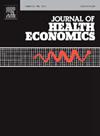我们是如何变老的?Gompertz定律的分解
IF 3.6
2区 经济学
Q1 ECONOMICS
引用次数: 0
摘要
人类生活的一个重要规律是冈珀茨定律,该定律预测死亡率随着年龄的增长呈近乎完美的指数增长。在本文中,我们考虑到计时年龄并不是死亡的原因,并将 Gompertz 定律分解为两个同样强大的定律:(i) 以虚弱指数衡量的健康缺陷的指数增长,以及 (ii) 虚弱指数与死亡率之间的幂律关联。我们展示了虚弱指数的增加如何从健康缺陷的自生产性特征中推导出来。我们探讨了 Gompertz 分解法在不同国家、不同性别和不同时期的稳健性,并展示了如何利用死亡率信息来推断年龄结构人口的健康状况。最后,我们用这种方法来推断过去人口的生理年龄,如 1940 年的澳大利亚人和 1770 年的瑞典人。本文章由计算机程序翻译,如有差异,请以英文原文为准。
How do we age? A decomposition of Gompertz law
A strong regularity of human life is Gompertz’s law, which predicts a near-perfect exponential increase in mortality with age. In this paper, we take into account that chronological age is not a cause of death and decompose Gompertz’s law into two equally strong laws: (i) an exponential increase in health deficits as measured by the frailty index, and (ii) a power law association between the frailty index and the mortality rate. We show how the increase in the frailty index can be derived from the feature of self-productivity of health deficits. We explore the robustness of the Gompertz decomposition across countries, sex, and over time and show how information about mortality rates can be used to infer the state of health of an age-structured population. Finally, we use this method to infer the biological ages of past populations, such as Australians in 1940 and Swedes in 1770.
求助全文
通过发布文献求助,成功后即可免费获取论文全文。
去求助
来源期刊

Journal of Health Economics
医学-卫生保健
CiteScore
6.10
自引率
2.90%
发文量
96
审稿时长
49 days
期刊介绍:
This journal seeks articles related to the economics of health and medical care. Its scope will include the following topics:
Production and supply of health services;
Demand and utilization of health services;
Financing of health services;
Determinants of health, including investments in health and risky health behaviors;
Economic consequences of ill-health;
Behavioral models of demanders, suppliers and other health care agencies;
Evaluation of policy interventions that yield economic insights;
Efficiency and distributional aspects of health policy;
and such other topics as the Editors may deem appropriate.
 求助内容:
求助内容: 应助结果提醒方式:
应助结果提醒方式:


